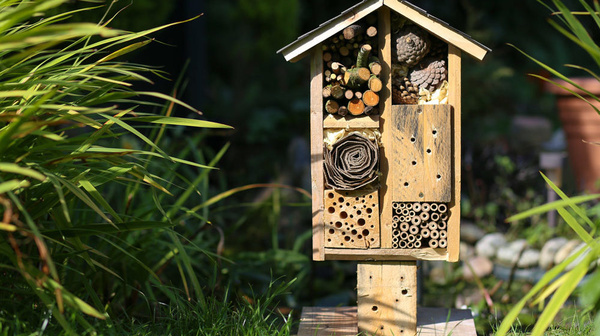
Build an Insect House for Your Garden
Attract beneficial insects to your garden by building an insect house. Fostering a healthy insect population promotes biodiversity, helps to prevent plant diseases, supports plant productivity, and recycles nutrients from plant matter back into the soil. Read our guide and build your own!
As a home gardener, you likely have done your fair share of research about pest control and infestation. However, it’s worth noting that not all insects are pests – in fact, many are beneficial. The presence of insects in and around your garden is actually a sign of health!
If you’ve never heard of an insect house (sometimes called an insect hotel), don’t worry. By the time you finish this blog, you’ll know what an insect house is, why you should consider putting one in your garden, and how to build your own.
What is an Insect House?
An insect house is exactly what it sounds like: a small structure that you can build or purchase and place in your garden to provide safe spaces for insects to call home.
Why would you want to do this?
Think about an insect’s natural home. You probably imagine rotting leaves, twigs, trees, logs, grass, or other natural parts of the environment. However, in an increasingly concrete environment, it can be difficult for insects to find permanent homes in residential areas. This is where an insect house comes in.
Why Put an Insect House in Your Garden?
Do you only think of insects as pests? Think again. Here are just a few of the benefits of creating a home for the insects in your garden:
- Many flowers and food crops require pollination, which is primarily done by bees, butterflies, beetles, moths, and other insects.
- Some insects – beetles, specifically – contribute to the decomposition of organic matter, helping to create rich, fertile soil for your plants. Nutrient recycling is a critical ecological process.
- Other insects help control the populations of those unwanted insects you are always trying to control. For example, ladybugs, hoverflies, and lacewings help control mite and lice populations.
- Insects act as food sources for other beneficial creatures like birds and bats.
Fostering a healthy insect population helps avoid using harmful chemical pest control products and saves money and time spent on soil additives. It also benefits gardens by promoting biodiversity, helping to prevent plant diseases, supporting plant productivity, and recycling nutrients from plant matter back into the soil.
Building Your Own Insect House
An insect house should imitate a habitat in which insects would naturally nest. Because different insects have different nesting habits and preferences, an insect house comprises various natural or recycled materials. This allows different species of insects to nest, reproduce, and hibernate in their new home.
Use an open birdhouse or wooden box as the insect house structure. You’ll need a variety of materials such as twigs, leaves, rolls of paper or thin cardboard, hollow reeds or bamboo, wooden blocks with holes drilled into them, straw, or pine needles. Make sure you also have a hot glue gun (and glue sticks) to secure the house materials.
Follow these steps to construct the house:
- Tightly roll any flat materials, like paper, cardboard, or leaves.
- Cut all materials to match the depth of the box.
- Choose one of your materials and secure it in a corner using hot glue.
- Continue packing the materials in the box, securing them with glue as needed.
- Pack the materials firmly while making sure not to crush other materials.
Location
Place your insect house directly on the ground, or attached to a stake, tree, or wall. An on-ground house will invite crawling insects, while an off-the-ground house will protect bee larvae from ants.
When choosing a location for the insect house, make sure:
- it is close to welcoming plants and vegetation, such as flowers that draw pollinators
- it is sheltered from rain and wind
- the house receives morning sun but is not exposed to full sun throughout the entire day
- it is well-secured and won’t be knocked over in a storm
Give it a few weeks for the insect house to establish. If it seems like the location is not working, you may carefully relocate the house. However, be patient. If the site and materials are right, it won’t be long before your garden is buzzing with healthy insect life!